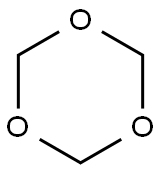1,3,5-트리옥세인
|
|
1,3,5-트리옥세인 속성
- 녹는점
- 59-62 °C(lit.)
- 끓는 점
- 112-115 °C
- 밀도
- 1.17
- 증기압
- 7.5 hPa (20 °C)
- 굴절률
- 1.4168 (estimate)
- 인화점
- 113 °F
- 저장 조건
- Store below +30°C.
- 용해도
- 221g/L
- 물리적 상태
- 결정 또는 결정질 플레이크
- 색상
- 무색~백색
- 폭발한계
- 3.6-28.7%(V)
- 수용성
- 221g/L(25℃)
- 승화점
- 115 ºC
- Merck
- 14,9734
- BRN
- 102769
- InChIKey
- BGJSXRVXTHVRSN-UHFFFAOYSA-N
- CAS 데이터베이스
- 110-88-3(CAS DataBase Reference)
안전
- 위험 및 안전 성명
- 위험 및 사전주의 사항 (GHS)
| 위험품 표기 | F,Xn | ||
|---|---|---|---|
| 위험 카페고리 넘버 | 11-37-63 | ||
| 안전지침서 | 36/37-46 | ||
| 유엔번호(UN No.) | UN 1325 4.1/PG 2 | ||
| WGK 독일 | 1 | ||
| RTECS 번호 | YK0350000 | ||
| 자연 발화 온도 | 777 °F | ||
| TSCA | Yes | ||
| HS 번호 | 2912 50 00 | ||
| 위험 등급 | 4.1 | ||
| 포장분류 | III | ||
| 유해 물질 데이터 | 110-88-3(Hazardous Substances Data) | ||
| 독성 | LD50 orally in Rabbit: 8190 mg/kg LD50 dermal Rabbit > 3980 mg/kg | ||
| 기존화학 물질 | KE-34722 |
1,3,5-트리옥세인 C화학적 특성, 용도, 생산
화학적 성질
Trioxane is a most unusual chemical. It is an excellent solvent for many classes of materials. Concentrated aqueous solutions of trioxane have solvent properties which are not possessed by trioxane itself. Molten trioxane dissolves numerous organic compounds, such as naphthalene, urea, camphor, dichlorobenzene, etc. It is stable in alkaline or neutral solutions, yet it is depolymerized to formaldehyde by small amounts of strong acid or acid-forming materials, and the rate of depolymerization can be readily controlled.용도
1,3,5-Trioxane is used in organic chemical processes such as aldol condensation of amides and syntheses of chloromethyl esters or other plastics.정의
ChEBI: A saturated organic heteromonocyclic parent that is cyclohexane in which the carbon atoms at positions 1, 3 and 5 are replaced by oxygen atoms.일반 설명
Transparent crystals or white crystalline solid with a pleasant odor resembling the odor of chloroform. Melts at 62°C; boils at 115°C without polymerization. The cyclic trimer of formaldehyde.공기와 물의 반응
Highly flammable. Water soluble.반응 프로필
s-Trioxane is stable under normal laboratory conditions but is unstable in the presence of acids, which initiate polymerization. Sublimes readily. May react with oxidizing matter . A stable polymeric product of formaldehyde that in the presence of strong aqueous acids will depolymerize (reforming the parent formaldehyde). Inert to strong alkalis. Readily converted in non aqueous solutions to the monomeric formaldehyde by small concentrations of acid---the rate of conversion is directly proportional to the concentration of the acid.건강위험
ACUTE/CHRONIC HAZARDS: s-Trioxane is toxic and flammable. It can emit toxic fumes on contact with acid or acid fumes.화재위험
s-Trioxane is combustible.Safety Profile
Mutation data reported. Can evolve toxic formaldehyde fumes when heated strongly or in contact with strong acids or acid fumes. Flammable liquid when exposed to heat, flame, or oxidzers. May explode when heated. Explosive in the form of vapor when exposed to heat or flame. Explodes on impact, possibly due to peroxide contamination. Mixtures with hydrogen peroxide are explosives sensitive to heat, shock, or contact with lead. Mixtures with liquid oxygen are highly explosive. Incompatible with oxidizing materials. To fight fire, use foam, CO2, or dry chemical. When heated to decomposition it emits acrid smoke and irritating fumes. See also FORMALDEHYDE.잠재적 노출
Paraformaldehyde is used in polyacetal resin manufacture; as a food additive; and as an odorless fuel.운송 방법
UN2213 Paraformaldehyde, Hazard Class: 4.1; Labels: 4.1-Flammable solid.Purification Methods
Crystallise 1,3,4-trioxane from sodium-dried diethyl ether or water, and dry it over CaCl2. It can also be purified by zone refining. [Beilstein 19 H 381, 19 II 392, 19 III/IV 4710, 19/9 V 103.]비 호환성
Paraformaldehyde dust forms an explosive mixture with air. Decomposes on contact with oxidizers, strong acids; acid fumes; and bases; with elevated temperatures, forming formaldehyde. May explode when heated. May explode on impact if peroxide contamination develops. Mixtures with hydrogen peroxide or liquid oxygen are explosives sensitive to heat, shock, or contact with lead.폐기물 처리
Dissolve or mix the material with a combustible solvent and burn in a chemical incinerator equipped with an afterburner and scrubber. All federal, state, and local environmental regulations must be observed.1,3,5-트리옥세인 준비 용품 및 원자재
원자재
준비 용품
Piperonyl chloride
Bis(2,3,3,3-tetrachloropropyl) ether
CHLOROMETHYL ISO-PROPYL ETHER
3,4-(Methylenedioxy)phenylacetonitrile
Chloromethyl methyl ether
아세토클로르
2-클로로-5-클로로메틸티오펜
글리신
water-proofing agent PF
CHLOROMETHYL BUTYL ETHER
클로로메틸에틸에테르
methyl triC^{9~11^} alkyl ammonium chloride
메틸3-메틸-2-부테노에이트
1,3,5-트리아진-1,3,5(2H,4H,6H)-트리에탄올
1,3,5-트리옥세인 공급 업체
글로벌( 278)공급 업체
| 공급자 | 전화 | 이메일 | 국가 | 제품 수 | 이점 |
|---|---|---|---|---|---|
| Shanghai Bojing Chemical Co.,Ltd. | +86-86-02137122233 +8613795318958 |
bj1@bj-chem.com | China | 299 | 55 |
| Capot Chemical Co.,Ltd. | +86-(0)57185586718 +86-13336195806 |
sales@capot.com | China | 29791 | 60 |
| Henan Tianfu Chemical Co.,Ltd. | +86-0371-55170693 +86-19937530512 |
info@tianfuchem.com | China | 21639 | 55 |
| SHANDONG ZHI SHANG CHEMICAL CO.LTD | +86 18953170293 |
sales@sdzschem.com | China | 2930 | 58 |
| Hebei Weibang Biotechnology Co., Ltd | +8615531157085 |
abby@weibangbio.com | China | 8817 | 58 |
| Xi'an Kono chem co., Ltd., | 029-86107037 13289246953 |
info@konochemical.com | China | 2993 | 58 |
| Hubei xin bonus chemical co. LTD | 86-13657291602 |
linda@hubeijusheng.com | CHINA | 22963 | 58 |
| CONIER CHEM AND PHARMA LIMITED | +8618523575427 |
sales@conier.com | China | 49374 | 58 |
| career henan chemical co | +86-0371-86658258 +8613203830695 |
factory@coreychem.com | China | 29815 | 58 |
| BEYOND INDUSTRIES (CHINA) LIMITED | +86-21-52699951; +8613917686115 |
sales@beyondindustriesgroup.com | China | 699 | 58 |
1,3,5-트리옥세인 관련 검색:
사이클로헥세인 이소트리데실알코올 산화알루미늄 트리알릴아민 Para-포름알데하이드 n-트리데칸 삼산화안티모니 1.4-다이옥세인 파라알데히드 1,3,5-트리옥세인
Tridecanoic acid
CYCLOHEXANE-D12
Trichloroparaldehyde
2,4-DIETHYL-6-METHYL-1,3,5-TRIOXANE
4,6-DIMETHYL-2-ETHYL-1,3,5-TRIOXANE
2,4,6-TRIS(1-CHLOROETHYL)-1,3,5-TRIOXANE
2,4,6-triisobutyl-1,3,5-trioxane
2,4,6-TRIPROPAN-2-YL-1,3,5-TRIOXANE









